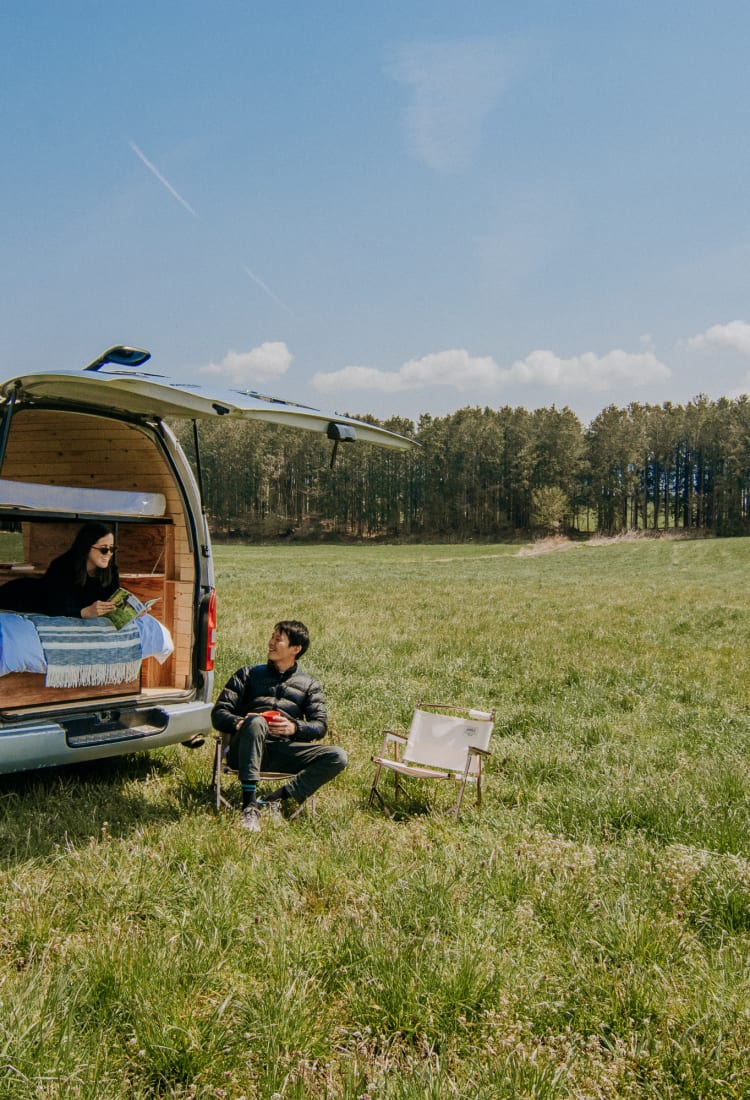
2020.10 Experience Vanlife: Road Tripping in Japan
Travel Japan at your own pace in a “mobile hotel”
Traveling in these “new normal” times necessitates changes in well-worn habits. Travelers increasingly want outdoorsy trips where social distancing is easy, and new travel styles that fit this trend are coming to the fore. One such travel style is “vanlife.” Traveling Japan in a customized van provides visitors with a sense of freedom and avoids busy public transportation and hotels. Discover why vanlife might be the perfect choice for your next trip.
Maximum comfort through minimal function
In Europe and America, vanlife has gained traction as a new lifestyle for the modern generation. The vehicles do much more than getting you from A to B. Vans can be comfortable lodgings and offices; compact spaces for living, working, and having fun.
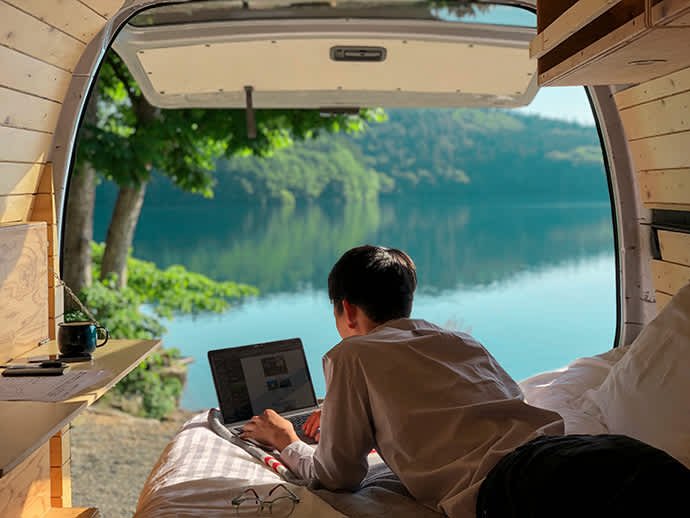
A digital nomad at work. Photo credit: Dream Drive Co., Ltd.
Vanlife is blossoming in Japan, too, perhaps due to the country’s long-running affection for camper vans and motor homes. Hajime Imoto runs a camper van rental company called Dream Drive, which provides vans that feature renovated interiors resembling hotel rooms. He believes that the popularity of his vans is due to their ease of mobility. The vans are easy to drive and park, and provide enough comfort without the need for excessive functions that drive the costs up.

Vanlife makes family travel much easier. (left) Right: The interior of a Dream Drive camper van. (right) Photo credit: Dream Drive Co., Ltd.
Camper van rental businesses are growing in line with the vanlife trend. Van travel works well in Japan because the vehicles can negotiate the country’s sometimes narrow roads better than a larger motor home. There are also over 1,000 Michi-no-Eki, or roadside stations, dotted around the country. These convenient facilities offer guests a place to eat, relax, take a bathroom break, and browse local foods and souvenirs. The over-1,000 campsites for automobiles mean finding a spot to stay overnight is relatively easy.
Perhaps more importantly, traveling Japan in a van offers the opportunity to visit Japan’s many delightful places that can only be accessed by a private vehicle.
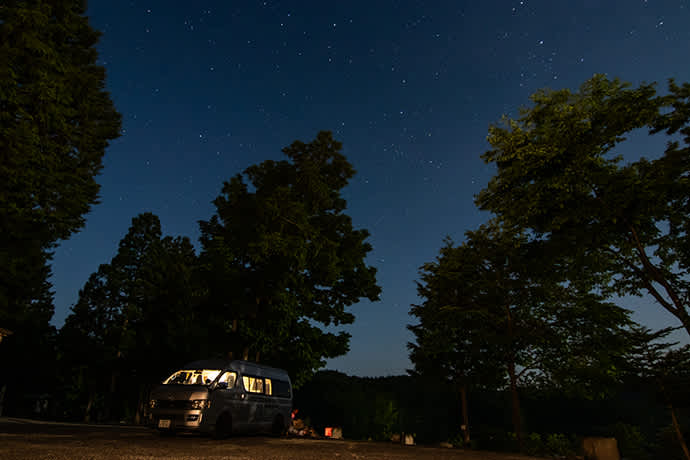
Japan’s auto-friendly campsites are very safe. Photo credit: Dream Drive Co., Ltd.
Camper vans come fully equipped and ready to travel
Camper vans vary in size and type, but most come equipped with a bed, sink, refrigerator, storage space, fold-up table, and window curtains.
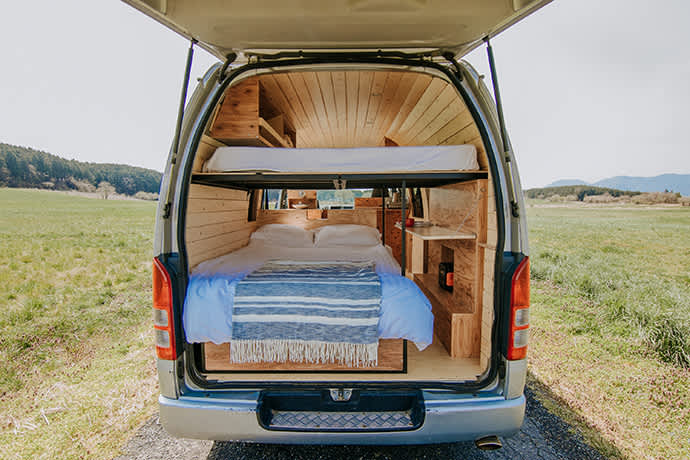
Japan has mastered the art of smart storage. Photo credit: Dream Drive Co., Ltd.
Many camper vans come with a host of other convenient items. Folding chairs and tables are ideal for an impromptu picnic, and kitchen drawers are stocked with enough tableware for the group. A hot-water heater will help keep out the chill, and a portable stove means you can cook wherever you choose to go. Van travelers can rent auxiliary batteries for use when the engine is not running and portable ones for mobile devices. Insurance and 24-hour roadside service support options provide peace of mind. Hajime explains that his vans are so well stocked that all you need is your wallet, driver’s license, and mobile device for a road trip.
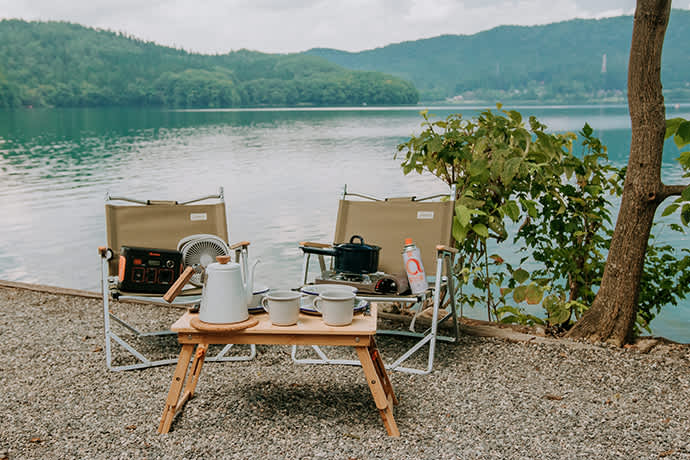
Fan and heater rentals make for a comfortable trip in any season. Photo credit: Dream Drive Co., Ltd.
A new way to discover Japan: explore the Mt. Fuji area in a camper van
Dream Drive recommends certain courses to travelers wishing to explore Japan in a camper van. One such course is a three-day, two-night trip around Yamanashi Prefecture, including the Fuji Five Lakes area near Mt. Fuji.
Day 1: Nature trekking and an open-air bath in beautiful surroundings
The drive from Tokyo to Nishizawa Gorge in Yamanashi Prefecture takes around 2.5 hours, including a stop on the expressway for lunch. Nishizawa is one of Japan’s top natural sights, featuring giant granite rocks shaped by centuries of erosion. A trekking path through the forest passes several waterfalls of varying sizes before reaching the beautiful Nanatsugama Godan Falls. This wooded hike is ideal for forest bathing and takes around three hours to complete.
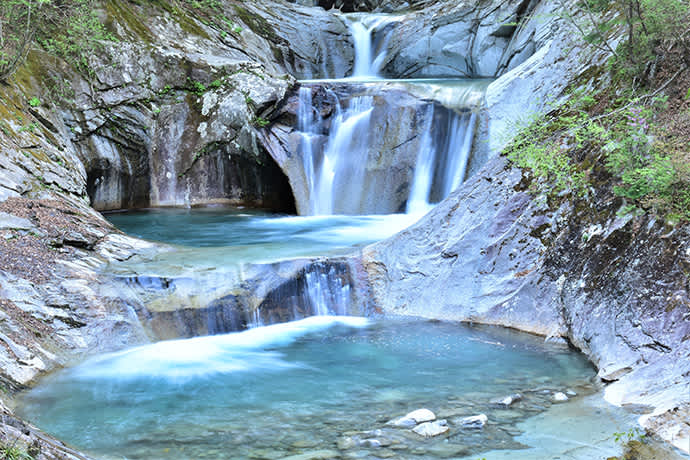
Nanatsugama Godan Falls
Next on the recommended agenda is Fuefukigawa Fruit Park, approximately 50 minutes from the gorge. Yamanashi is a major fruit-producing region, and visitors to the park can purchase local fruit products. During the fall, Shine Muscat are in season and are a must-try for all lovers of juicy grapes. The park has a children’s playground and offers hands-on farming experiences.
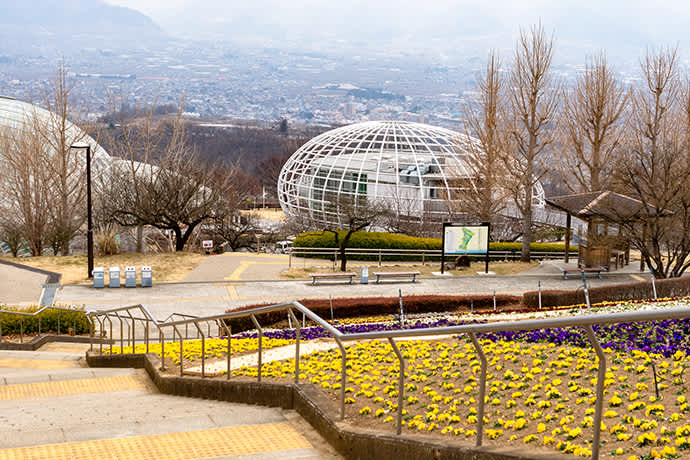
Discover Yamanashi local fruits at Fuefukigawa Fruit Park.
Around five minutes from the park is Hottarakashi Onsen, the perfect spot to relax after your first day of vanlife in Japan. This hot spring has two open-air baths with views of Japan's most iconic peak: Mt. Fuji.
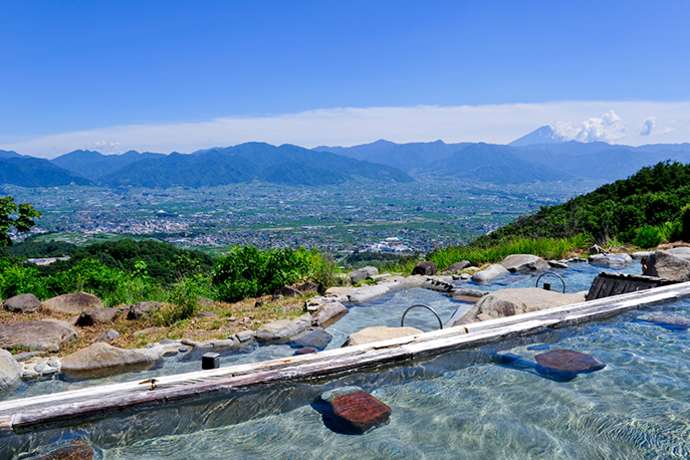
View of Mt. Fuji from the outdoor bath at Hottarakashi Onsen.
Having access to a private vehicle allows you to choose from a range of dining options. Consider trying some of the local Yamanashi fare. Hoto—flattened noodles packed into a warming hot pot of vegetables and simmered in a miso soup—is perhaps the prefecture’s most famous dish. All that’s left after enjoying a hearty meal is to retire to your camping location and have a good night’s rest in your camper van.

A hoto hot pot; ingredients vary depending on the restaurant. (left) Viewing Mt. Fuji from a camping spot in the Fuji Five Lakes area. (right) Photo credit: Dream Drive Co.,Ltd
Day 2: Exploring the Fuji Five Lakes area and Japan’s most iconic mountain: Mt. Fuji
The second day of the course begins at Kawaguchi Asama Shrine, around an hour’s drive south from the Hottarakashi Onsen area. Kawaguchi Asama Shrine dates back to 865. It was purpose-built to appease Mt. Fuji after it erupted in 864. The shrine forms part of the UNESCO World Heritage site collectively known as “Fujisan, sacred place and source of artistic inspiration.” Seven giant trees on the shrine grounds are more than 1,200 years old.
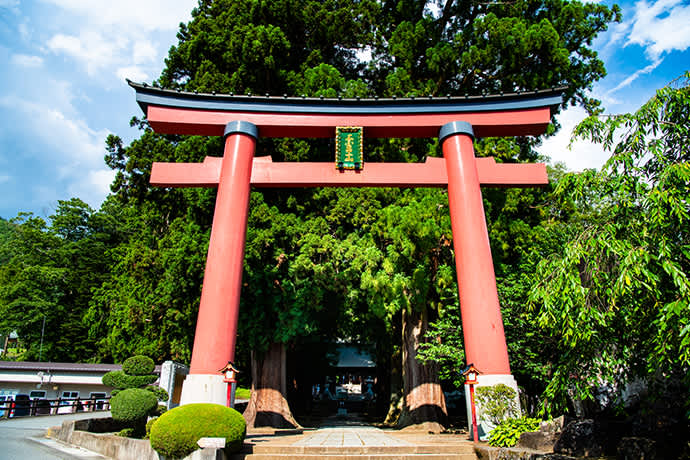
The torii gate at Kawaguchi Asama Shrine.
After exploring the atmospheric shrine grounds, visit Haha-no-Shirataki Waterfall in the mountain behind the shrine. The road leading to the parking area for the falls is narrow. However, it is generally no problem for the Dream Drive vans, which have good maneuverability and a small turning radius.
Viewing the tumbling water and taking in the crisp mountain air does wonders for the soul. Many years ago, mountain climbers heading to the summit of Mt. Fuji would cleanse their bodies under the falls.
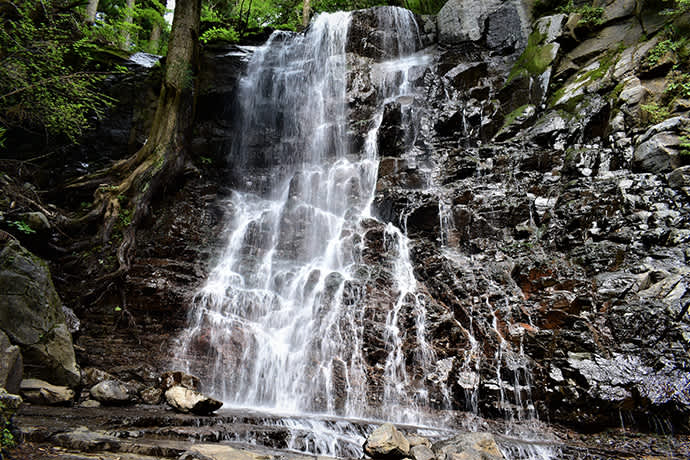
Haha-no-Shirataki Waterfall.
Next, return to the van and drive 35 minutes west. Enjoy views of the expansive Lake Kawaguchi and Lake Saiko along the way before arriving at Saiko Iyashi no Sato-Nenba, a historical village with beautiful vistas of Mt. Fuji. This themed village features traditional Japanese thatched-roof houses. Wander inside the 20 houses where you will find restaurants, galleries offering woodwork and pottery activities, and a souvenir shop. Enjoy a lunch of soba noodles and get a feel for a traditional Japanese lifestyle.
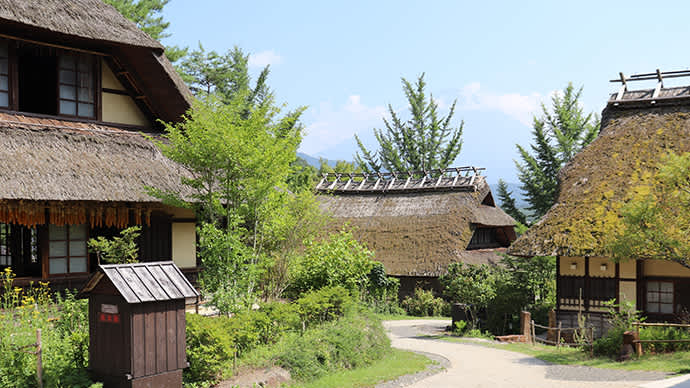
Explore a traditional Japanese landscape at Saiko Iyashi no Sato-Nenba.
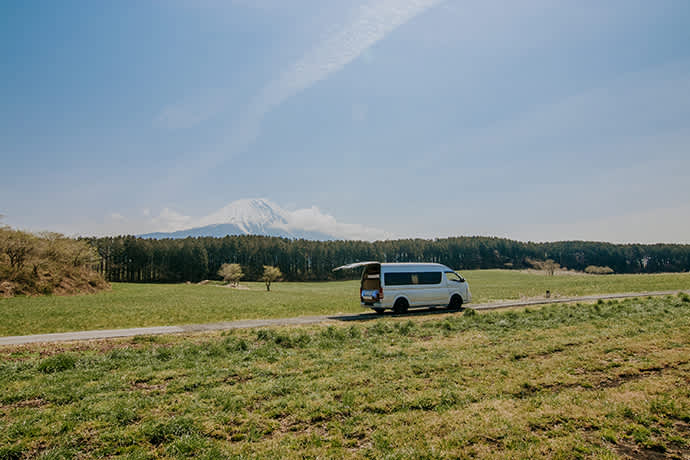
Vanlife means you can explore on your own schedule and relax when you need to. Photo credit:Dream Drive Co.,Ltd
A further 40 minutes west is Lake Motosu, the westernmost of the Fuji Five Lakes. Head along Prefectural Road No. 709 and park the van at the trailhead to hike to the Nakanokura Toge Mountain Pass Observatory on the lake’s northern side. It takes around 30 minutes on foot to reach the observatory. Upon arrival, open your wallet and pull out a 1,000-yen note. If weather conditions are favorable, you will notice that the image printed on the note of Mt. Fuji reflected in water—an iconic image known as “upside down Fuji”—is the same as the view from the observation deck.

Mt. Fuji viewed from Nakanokura Toge Mountain Pass Observatory. (left) The image on the back of the 1,000-yen bill. (right)
Don’t forget to take a picture as a memento before heading off to the Lake Saiko area and a nearby onsen to relax away the day’s fatigue. After enjoying another dinner of local cuisine, drive to the lakeside campsite for the night.
Day 3: Exploring the forest caves at the base of Mt. Fuji
After another restful night in the van, set out for Aokigahara Forest—the huge virgin forest that spreads out at the base of Mt. Fuji. The forest, not far from Lake Saiko, forms part of the Fuji-Hakone-Izu National Park.
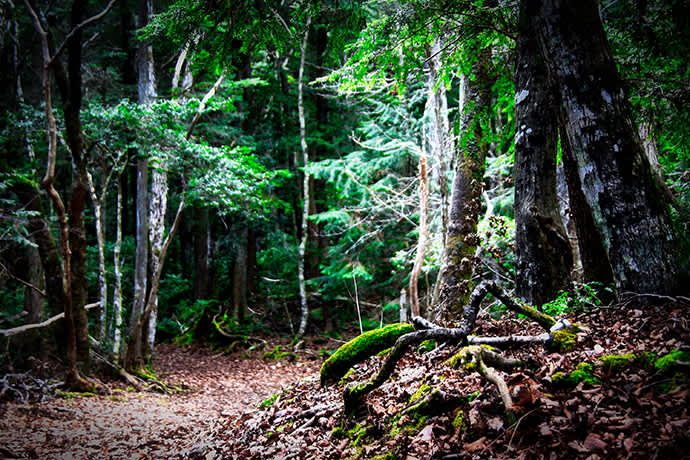
The entrance to Aokigahara Forest at the base of Mt. Fuji.
Aokigahara is home to two distinctive caves: Fugaku Wind Cave, which formed after lava from a Mt. Fuji eruption 1,200 years ago covered the area, and Narusawa Ice Cave, which has ice pillars even in the middle of summer. Join a guided tour to explore the area. The expansive and maze-like forest can be disorienting, and it is dangerous to explore without professional guidance. Tours are available in English, French, and Chinese.
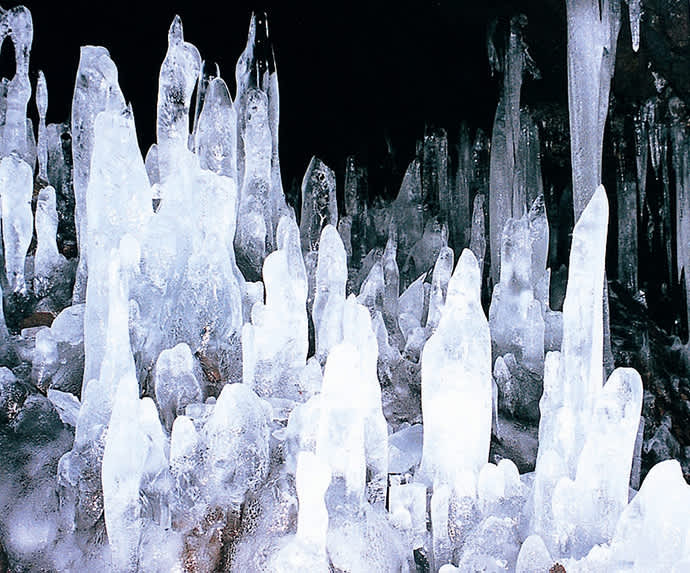
Ice pillars in Narusawa Ice Cave.
The final stop on the recommended tour before returning to Tokyo is Arakurayama Sengen Park. The park is an iconic place for snapshots of Mt. Fuji looming behind an ornate five-story pagoda. Visitors in spring have an opportunity to take a photo of three Japanese symbols in one shot when the cherry blossoms add to the traditional Japanese ambiance.
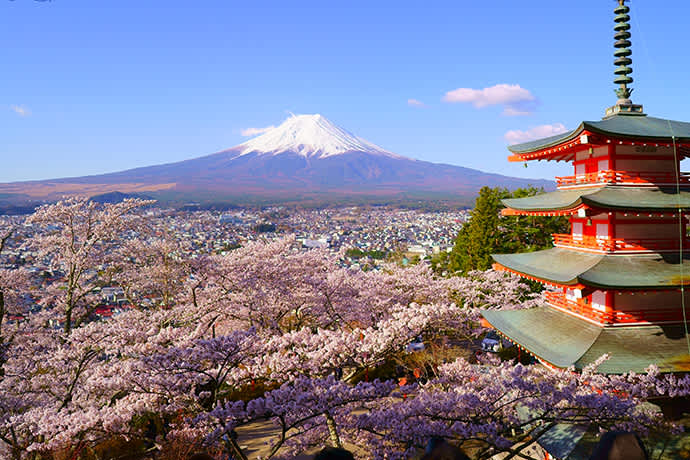
The spring cherry blossoms bloom at Arakurayama Sengen Park.
A variety of camper vans
Carstay is Japan’s first van-sharing service. The company introduces camper van owners to those wishing to embark on a road trip in Japan. The company has a wide range of vans on their books, from large models suitable for families to smaller, retro-style vehicles.
Large vans
The largest van model is the Hiace, a popular choice for families. The van seats five and can sleep two adults and two children.

Total length of the Hiace is 5.8 yards (5.3 meters) (left). A three-quarter bed in the back of the Hiace (right). Photo credit: Carstay Co., Ltd.
Other large camper van options include converted buses. These “Traveling Hotels” measure approximately 7 yards in length (6.4 meters) and can seat eight people.
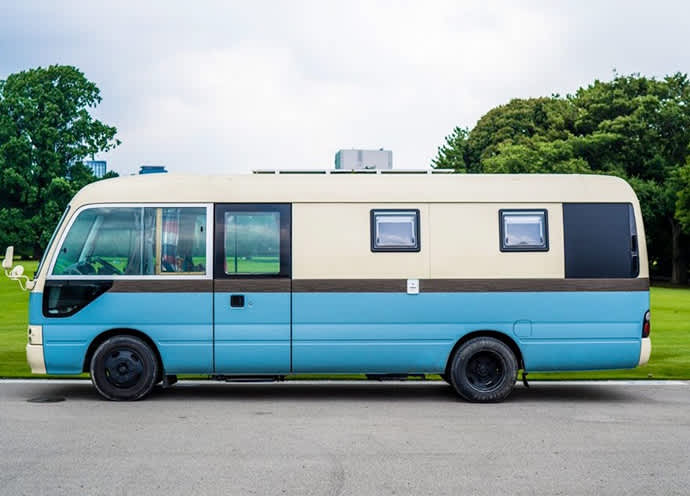
Converted buses become “traveling hotels.” Photo credit: Carstay Co., Ltd.
Medium-size vans
Retro Volkswagen vans remain a popular choice. These regular-sized vehicles seat six and can sleep two adults and three to four children.
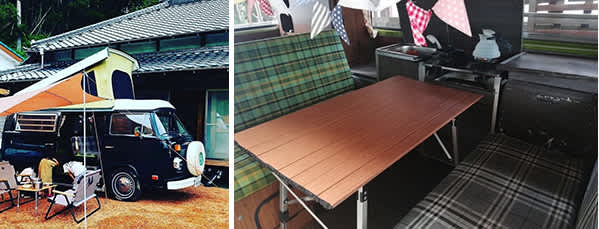
Classic Volkswagen vans have a retro charm. (left) The café-like interior of a van. (right) Photo credit: Carstay Co., Ltd.
The Nissan Caravan is another popular choice. This van seats three and sleeps two adults and one child.
Compact vans
Smaller, more compact vehicles are ideal for less-experienced drivers. The vans have turbo functions that can handle mountain roads. This type seats two and sleeps two.

Smaller vans can manage Japan’s narrow roads with ease. (left) The bed folds up to become a sofa. (right) Photo credit: Carstay Co., Ltd.
Notes on parking in Japan:
Parking at Michi-no-Eki roadside stations is free but staying overnight is generally prohibited. Use these sites for short naps and temporary parking. There are campsites around the country suitable for automobiles. They are well-maintained and equipped with bathrooms and electricity. For peace of mind, consider reserving a spot through Carstay. The company has access to private parking areas throughout Japan that can be used by those traveling Japan in a Carstay van.
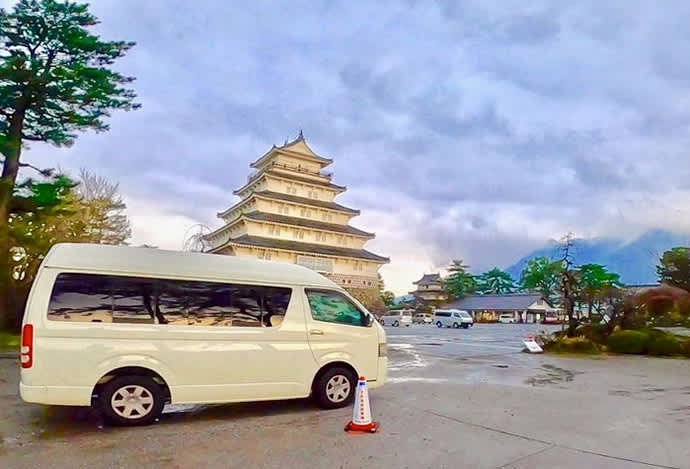
Carstay provides access to overnight parking spots—some in unique locations. Photo credit: Carstay Co., Ltd.
Information
Dream DrivePopular for all-inclusive services and year-round, 24-hour hospitality. |
CarstayAt the time of writing (October 2020), there are 70 vans for sharing and 230 registered overnight parking spots. The number of parking spots is regularly increasing. English available. Online reservations. |
Related Links
Mt. Fuji Yamanashi Guide-Interpreters AssociationGuided tours of Aokigahara Forest available. Online reservations. |
Nishizawa Gorge, Nanatsugama Godan FallsMitomikawaura, Yamanashi-city,Yamanashi Prefecture |
|
WEB:https://www.yamanashi-kankou.jp/foreign/english/spot/p1_4789.html |
Fuefukigawa Fruit Park |
|
WEB:https://www.yamanashi-kankou.jp/foreign/english/spot/p2_4460.html |
Hottarakashi Hot Springs |
|
WEB:https://www.yamanashi-kankou.jp/foreign/english/stay/037.html |
Kawaguchi Asama Shrine |
|
WEB:https://www.yamanashi-kankou.jp/foreign/english/spot/p1_4445.html |
Haha-no-Shirataki Waterfall |
|
WEB:https://www.yamanashi-kankou.jp/english/recover/mothers-white-waterfall.html |
Saiko Iyashi no Sato-Nenba |
|
WEB:https://www.yamanashi-kankou.jp/foreign/english/spot/p2_2803.html |
Nakanokura Toge Mountain Pass Observatory |
|
2926 Kawajiri, Nakanokura, Minobu-cho, Minamikoma-gun, Yamanashi Prefecture |




























































